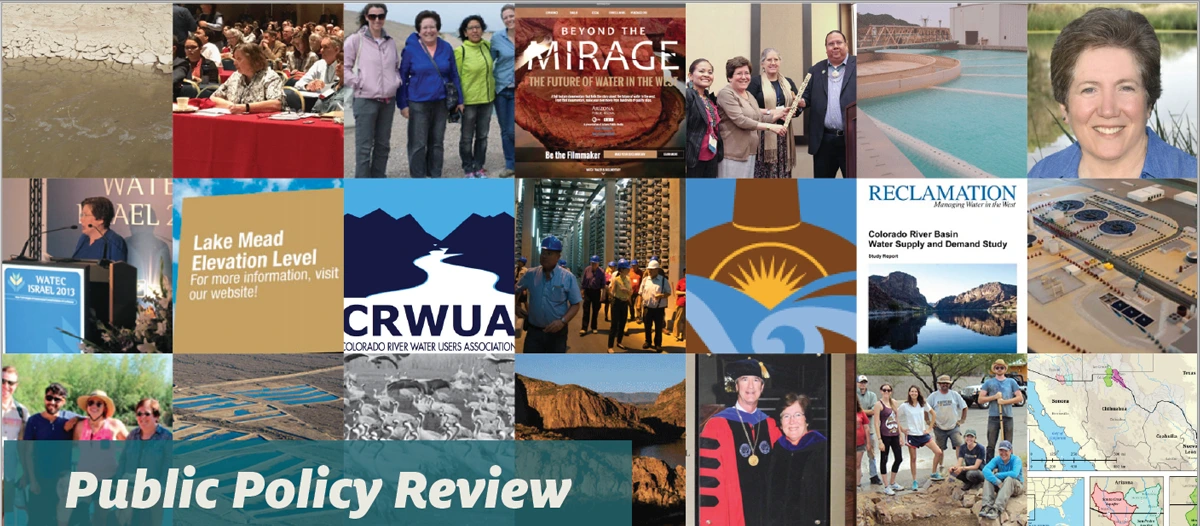
I have contributed a column to the Arizona Water Resource newsletter since joining the University of Arizona Water Resources Research Center in February 2002. As the WRRC closes the book on the quarterly Arizona Water Resource, I am using this 76th column as the foreword to a compilation of my columns. The compiled volume is being published electronically and posted on the Water Resources Research Center’s website. Since 2013, my columns have been the first reading assignment for my graduate water policy class, now entitled “Water Policy in Arizona and Semi-arid Regions”. I ask students to come to the second meeting of the class with multiple questions that emanate from their review of the columns. Student questions then guide the second class’ discussion and provide me with a glimpse of subjects the students may address in the research papers they write for the class. My rationale for this assignment is that, when I look at my past columns, I see that many of the issues I wrote about in the past continue to be matters of current debate.
When I first thought about this column/Foreword, I thought I would identify my favorite columns or those for which I received the most comments. I am pretty sure I received the most feedback for Column 36, “An American in Paris Realizes Arizona Could Do More to Save Water”, which in fact is one of my favorites. The high number of comments was most likely due to the photo of me touring the Paris Sewer Museum. Sometimes what is most memorable is where I was when I wrote the column, such as Column 55, “Written from Sea”. I wrote that column while on an Alaskan cruise vacation. There are the several columns written during or after teaching my Spring semester graduate water policy class, where I discuss student papers and/or the interesting field trips taken or topics we have covered. There are columns written about other experiences, such as organizing workshops and conferences and working on the Transboundary Aquifer Assessment Program. There are the columns written about other very interesting trips abroad, including that taken in late 2016 with the two International Boundary and Water Commissioners. And there are the issues-focused columns, including several about water planning, water recharge, groundwater invisibility, water conservation and pricing, etc.
Rather than choose my top 10 columns, however, I decided to return to my first column, published in the March-April 2002 Arizona Water Resource and entitled, “Was the GWMC’s [Groundwater Management Commission’s] Conversation Comprehensive Enough?” In particular, I want to highlight this paragraph: “Because we have been successful at managing our groundwater, no crises exist nor loom on the horizon. As a result, there is no strong sense we should do anything differently. And while the commission and its onlookers engaged in a comprehensive conversation, for the most part the general public and public officials did not. Further education, discussion and debate, therefore, is needed, especially with legislators and likely participants in future legislative debates.” Now, many years later, we are at a very critical juncture in Arizona water management as we grapple with how to absorb the expected reductions in deliveries of Colorado River water to Arizona. There is a comprehensive conversation going on as I write this column. The conversation includes legislators and representatives of the various water using sectors in Arizona. As the impacts of the proposed terms of the Drought Contingency Plan are being explored and debated by a large steering committee, we know that it is more important than ever to build upon the great water management foundations and collaborations that have contributed to Arizona’s economic vitality.
The need for education and robust dialogue on water policy and management is as great as ever. Although, the Water Resources Research Center is ceasing publication of the Arizona Water Resource as we know it to keep in step with society’s changing approaches to information sharing and enable us to realign Water Resources Research Center resources, I intend to continue to share perspectives periodically through our Weekly Wave news digest. If you do not already subscribe to this Friday e-publication, which includes announcement of our seminars (usually live-streamed) and annual conference, along with short articles, please subscribe.
As always, I invite you to provide your feedback by emailing me at smegdal@email.arizona.edu.
Compendium pdf can be found here.

